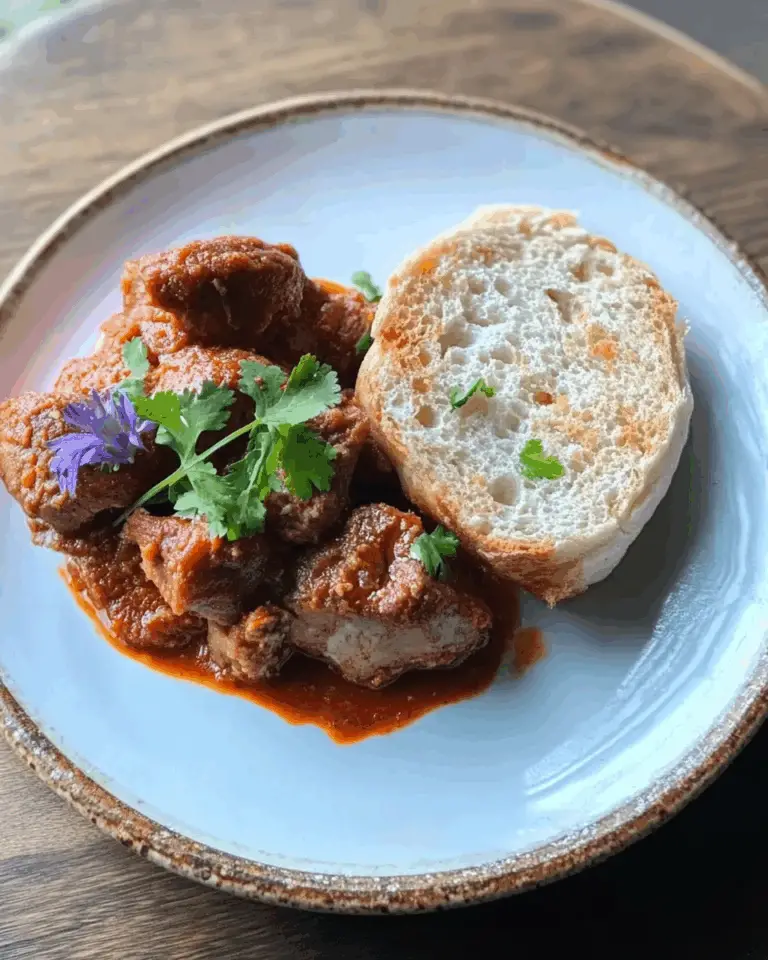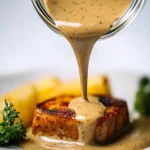This flavorful Pork Vindaloo with Poe Bread is a cherished Goan recipe I learned from close family friends in Mumbai. Pork Vindaloo is a staple in Goan Catholic homes, known for its bold, spicy, tangy, and slightly sweet flavor profile. It’s traditionally served with soft, fluffy poe—a whole wheat bread that’s perfect for soaking up the sauce. This dish is deeply nostalgic and perfect for sharing over a hearty meal.
Full Recipe:
Ingredients
For the Pork Vindaloo:
-
1.5 pounds St. Louis-style ribs
-
2 medium white onions, finely diced
-
4 tablespoons olive oil
-
5 tablespoons garlic, finely chopped
-
3 tablespoons ginger, finely chopped
-
2 tablespoons The Indian Pantry Vindaloo masala (adjust to taste)
-
4 tablespoons white vinegar
-
1 teaspoon red chili powder
-
1 teaspoon cane sugar
-
1 cup water
-
Salt, to taste
-
Fresh cilantro, for garnish
For the Poe Bread:
-
1.5 cups whole wheat flour
-
1 cup all-purpose flour
-
2 teaspoons yeast
-
1 teaspoon salt
-
1 tablespoon sugar
-
1 cup water
-
2 teaspoons oil
-
5 tablespoons wheat bran
Directions
To Make the Pork Vindaloo:
-
In a bowl, marinate the ribs with vindaloo masala, white vinegar, sugar, chili powder, and salt. Let sit for 30 minutes.
-
Heat olive oil in a medium crock pot over medium heat. Add onions and sauté until translucent.
-
Add chopped ginger and garlic; sauté for 3–4 minutes.
-
Add marinated ribs and sauté for 2 minutes.
-
Add water, reduce heat, and simmer uncovered on low-medium heat for about 45 minutes, or until pork is tender.
-
Garnish with fresh cilantro. Serve hot with poe bread.
To Make the Poe Bread:
-
Activate yeast with warm water and sugar. Let it sit until frothy.
-
Mix all ingredients except wheat bran into a dough. Knead until smooth.
-
Cover and proof the dough for 2 hours, or until doubled in size.
-
Divide into six equal portions. Roll into rounds, ½ inch thick.
-
Sprinkle wheat bran on top and proof again for 45 minutes.
-
Preheat oven to 400°F. Bake for 8–10 minutes until lightly golden.
-
Serve warm with the pork vindaloo.
Nutrients (Approx. per serving including bread)
-
Calories: 620 kcal
-
Protein: 32g
-
Carbohydrates: 48g
-
Fat: 34g
-
Saturated Fat: 10g
-
-
Sugar: 5g
-
Fiber: 5g
-
Cholesterol: 85mg
-
Sodium: 580mg
-
Iron: 4mg
-
Calcium: 45mg
-
Vitamin C: 6mg
The History and Cultural Roots of Vindaloo
The name “vindaloo” has its origins in the Portuguese dish carne de vinha d’alhos—literally meat with wine and garlic. When the Portuguese brought this preparation to Goa in the 15th century, local cooks adapted it using ingredients native to India: vinegar instead of wine, palm sugar instead of refined white sugar, and the addition of regional spices like chili, cumin, and turmeric.
Over time, pork vindaloo became a staple in Goan Catholic homes, especially during festive occasions, Christmas meals, weddings, and Sunday feasts. Its unique flavor—a combination of savory, sour, spicy, and subtly sweet—makes it one of the most complex and celebrated dishes in regional Indian cuisine. While vindaloo can now be found in Indian restaurants across the world, the authentic Goan version is distinct and deeply personal to those who grew up eating it.
A Dish Built on Layers of Flavor
What makes pork vindaloo truly unforgettable is the depth of its flavor. At its heart are marinated pork ribs, typically St. Louis-style ribs, which have a balance of meat and fat that makes them ideal for slow braising. The marinade—made with vinegar, garlic, ginger, chili powder, and vindaloo masala—is where the transformation begins. As the pork rests in this mixture, it begins to absorb the tangy, spicy, and sweet elements that will later infuse the entire dish.
Once seared and simmered, the pork becomes tender and juicy, falling off the bone and releasing its fat into the spiced gravy. The sauce thickens and darkens as it reduces, creating a rich, aromatic base that clings beautifully to every bite. This is comfort food elevated—familiar yet exciting, homey yet exotic.
The Role of Vinegar and Sugar
A defining characteristic of pork vindaloo is its use of vinegar, which sets it apart from many other Indian curries. The acidity from the vinegar brightens the dish, balances the fatty richness of the pork, and enhances the depth of the spices. It cuts through the intensity with a refreshing sharpness, ensuring the dish doesn’t become overwhelming.
Sugar, typically cane sugar in traditional Goan kitchens, adds a necessary counterpoint to the sourness and heat. It rounds out the edges, making the dish more approachable and layered. The result is not a sweet curry but rather a well-balanced one—each bite delivering spice, tang, and a lingering richness that keeps you going back for more.
Aromatic Base: Onion, Garlic, and Ginger
The flavor base of vindaloo rests on the golden trio of onions, garlic, and ginger. These ingredients are slowly sautéed until aromatic, releasing their natural sweetness and earthiness. This base serves as the aromatic foundation upon which the marinated pork and sauce are layered. As the dish simmers, these ingredients melt into the sauce, thickening it and enriching its flavor.
While this technique is common in many Indian dishes, its execution in vindaloo is especially important, as it ensures the sauce is rich, velvety, and full of body. The garlic and ginger also bring warmth and pungency that plays beautifully against the vinegar’s brightness and the pork’s savory depth.
Why Poe Bread Is the Perfect Pairing
No pork vindaloo is complete without poe bread, a lightly fermented, whole wheat flatbread unique to Goa. Poe is soft and pillowy with a slightly chewy bite, dusted with wheat bran on top for texture and visual appeal. It’s made with a mix of whole wheat and all-purpose flour, which gives it a hearty but not overly dense quality—perfect for mopping up thick, flavorful curries.
Poe has cultural significance beyond its role as an accompaniment. Sold by local poders (bakers), it represents a unique tradition of Goan baking that blends Portuguese and Indian methods. Unlike naan or paratha, poe isn’t fried or grilled—it’s baked, giving it a rustic, almost sourdough-like character. Served warm and fresh out of the oven, it absorbs the spicy, tangy vindaloo sauce beautifully, turning every bite into a perfectly balanced mouthful of flavor and texture.
A Dish for Special Occasions
While pork vindaloo and poe bread can certainly be enjoyed any time of year, they’re especially meaningful during celebrations and family meals. Many Goan households prepare vindaloo for Christmas, Easter, and weddings, where it’s served alongside rice, pickles, and other celebratory dishes. It’s also a dish that improves over time—leftovers develop even more depth, making it a popular make-ahead option for large gatherings.
The dish also serves as a point of connection—between generations, between regions, and between cultures. For those of Goan heritage or those with close ties to the region, it represents home, memory, and community. For others, it’s an invitation to explore a lesser-known but deeply flavorful corner of Indian cuisine.
Adapting the Dish to Modern Kitchens
While traditional Goan vindaloo may take hours and feature fresh-ground spice pastes, this version simplifies the process using a high-quality vindaloo masala blend and stovetop braising. It’s designed for the modern home cook, with no compromise on flavor. The use of St. Louis-style ribs makes the dish feel hearty and substantial, while the crock pot or stovetop simmering makes it manageable for everyday cooking.
Even the poe bread, which traditionally requires wood-fired ovens, is adapted for home ovens using a mix of flours, yeast, and wheat bran. Though it requires some proofing time, the dough is easy to handle and delivers that authentic, rustic flavor with a softer crumb.
Health and Nutritional Balance
This dish, while indulgent, offers a solid nutritional profile. With approximately 620 calories per serving, including the bread, it provides 32 grams of protein—primarily from the pork—and fiber from whole wheat flour and bran. While the fat content is moderate due to the ribs, it’s balanced with complex carbs from the poe and minimal added sugar. It’s a well-rounded, satisfying meal that doesn’t rely on excessive oils or cream, making it suitable for those seeking bold flavors without sacrificing nutritional awareness.
Conclusion
Pork Vindaloo with Poe Bread is more than just a recipe—it’s a story of heritage, celebration, and culinary craftsmanship. Rich in flavor and rooted in centuries of cultural exchange, it represents the heart of Goan Catholic cuisine. The bold spices, tangy vinegar, tender pork, and chewy wheat bread come together in harmony, creating a meal that is both deeply comforting and impressively complex.
Whether you’re recreating a beloved dish from your childhood, introducing friends to new flavors, or simply seeking a soul-satisfying dinner, this pork vindaloo delivers on every level. It’s a dish that brings people together, evokes memory, and celebrates the beauty of tradition through every bite.






